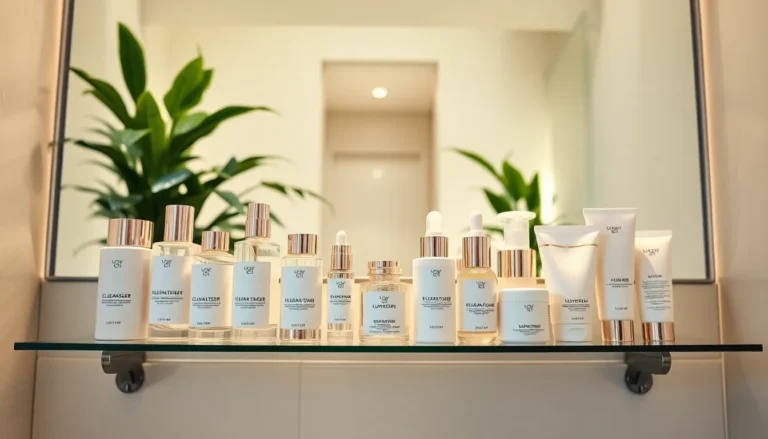Table of Contents
ToggleEver had that moment when your iPhone suddenly chimes in with a “too close” warning, making you feel like it’s judging your personal space? It’s like having a digital buddy that’s a little too concerned about your proximity. While it’s great that Apple looks out for your health, sometimes you just want to enjoy your favorite show without your phone interrupting the drama.
Understanding The iPhone Too Close Warning
The iPhone “too close” warning alerts users when they hold the device too near their eyes. This feature aims to promote eye health by encouraging safe viewing distances. Apple’s focus on health draws attention to the potential risks of prolonged close-range screen time.
Several factors trigger this warning. The device’s sensors detect proximity and gauging the distance works to reduce eye strain. Users often experience notifications when using apps or watching videos, especially in low-light conditions.
Receiving the warning can disrupt enjoyment, yet it serves a purpose. Apple designed this feature to protect users from potential long-term damage. An optimal viewing distance promotes better visual health and overall comfort.
Some users find the frequent alerts bothersome. Constant notifications may lead to frustration, especially during activities such as watching shows or playing games. Understanding the reasoning behind these warnings helps users appreciate the balance between health and convenience.
Adjusting viewing habits can reduce notifications. Keeping a distance of at least 12 inches from the screen can minimize the likelihood of receiving these alerts. Additionally, adjusting brightness settings might also prove helpful in preventing disturbances.
Navigating through these warnings requires awareness of the health benefits involved. Users must balance personal enjoyment and device safety. Each warning serves as a reminder to practice healthy habits with technology.
Reasons For The Too Close Warning
The “too close” warning from the iPhone serves essential purposes related to health and user experience.
Safety Features Of The iPhone
iPhones integrate sensors that detect how near the device is to a user’s eyes. When the screen is closer than the recommended 12 inches, it generates alerts to encourage safe viewing distances. These safety features aim to minimize eye strain, promoting long-term eye health. Technology advancements help ensure users embrace preventative measures effortlessly. Alerts primarily activate during specific activities, such as app usage or video watching in dim lighting conditions.
User Experience Concerns
Frequent notifications can disrupt user experiences. They often interrupt activities like gaming or watching shows, causing frustration among users. Understanding the purpose of these alerts doesn’t eliminate the inconvenience they might cause. Some prefer a more seamless interaction, free from health warnings. Altering habits, such as adjusting screen brightness or viewing distance, can help mitigate the occurrence of these notifications. Awareness of device settings offers users the power to improve personal experiences while still prioritizing well-being.
How To Turn Off iPhone Too Close Warning
Disabling the “too close” warning on an iPhone offers a more uninterrupted experience. Users can follow straightforward steps to achieve this.
Steps To Disable The Warning
- Open the Settings app. Start by tapping the Settings icon on your home screen.
- Navigate to Display & Brightness. Scroll down and select Display & Brightness from the list.
- Adjust the Auto-Brightness setting. Toggle off Auto-Brightness if it’s enabled. This action can lessen the frequency of proximity warnings.
- Check for Accessibility settings. Go to the Accessibility section and look for Display Accommodations. Adjusting settings here also helps minimize alerts.
These steps provide a clear path to less frequent notifications related to device proximity.
Reverting Changes If Necessary
Restoring the original settings is simple if notifications become bothersome once more.
- Return to Settings. Tap the Settings app again on your device.
- Visit Display & Brightness settings. Go back to Display & Brightness.
- Reactivate Auto-Brightness. Enable Auto-Brightness to restore its previous functionality.
- Inspect Accessibility settings. Ensure Display Accommodations revert to the defaults.
These actions return the iPhone to its initial setup, reinstating protective alerts as desired.
Alternatives To Turning Off The Warning
Users can explore various options to manage the “too close” warning on their iPhones without completely disabling it. Some strategies help maintain a balance between device usage and eye health.
Adjusting Your Usage Habits
Maintaining a safe distance from the screen proves beneficial. Users can aim to hold their device at least 12 inches away from their eyes during use. Taking regular breaks also reduces the frequency of notifications, especially during longer viewing sessions. Incorporating ambient lighting within the environment counters the low-light triggers that often prompt these warnings. Additionally, limiting use during dark settings decreases the likelihood of receiving alerts, enhancing overall comfort.
Using Accessibility Features
Accessibility features on the iPhone can ease the disruption caused by alerts. Users can enable features such as VoiceOver or Zoom, making the interaction experience smoother and more manageable. Adjusting display settings improves visual comfort, which helps mitigate warnings as well. Screen accommodations, like increasing text size, allow users to view content from a distance without strain. Lastly, utilizing the Grayscale option may reduce screen intensity, contributing to a more pleasant viewing experience.
Turning off the iPhone “too close” warning can enhance the user experience during activities like watching videos or gaming. By following simple steps in the Settings app users can minimize interruptions while still being mindful of eye health.
It’s essential to find a balance between enjoying device features and protecting one’s vision. Adjusting viewing habits and utilizing accessibility options can also create a more comfortable interaction with the device. Ultimately users can enjoy their favorite content without compromising on safety or comfort.




